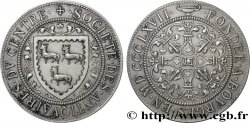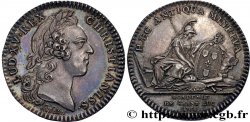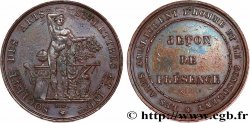fme_492470 - ACADEMIES AND LEARNED SOCIETIES Médaille, société d’encouragement
Not available.
Item sold on our e-shop (2019)
Price : 300.00 €
Item sold on our e-shop (2019)
Price : 300.00 €
Type : Médaille, société d’encouragement
Date: 1833
Metal : silver
Orientation dies : 12 h.
Weight : 95,02 g.
Edge : lisse + lampe
Puncheon : Lampe (1832 - 1841)
Coments on the condition:
Traces de nettoyage dans les champs de l’avers. Jolie patine au revers malgré les traces d’un nettoyage ancien
Obverse
Obverse legend : SOCIETE D’ENCOURAGEMENT. // FONDEE LE IX BRUM. / AN X. 1802..
Obverse description : Allégorie tenant deux couronnes de laurier, instruments mécanique et de mesure autour d’elle. Signé : TIOLIER F..
Reverse
Reverse legend : DÉCERNÉE / A / M M. MOTARD / ET DE MILLY / BOUGIES STEARIQUES / ENCOURAGEMENT / 1833..
Reverse description : Inscription en 7 bougies dans une couronne de laurier.
Commentary
Dans le Bulletin de la société d’encouragement pour l’industrie nationale, 32e année, mai 1833, une mention des messieurs Motard et de Milly est faite dans un extrait des procès verbaux des séances du Conseil d’administration de la société d’Encouragement du 8 mai 1833.
“Mr Payen lit les rapports suivants : [...] Sur les bougies stéariques dites de l’Etoile, fabriquées par MM. de Milly et Motard. Le Comité propose de donner à ces fabricans un témoignage de la satisfaction de la Société, en leur accordant une médaille. Cette proposition est renvoyée à la Commission des médailles.”
Un peu plus loin dans le texte est mentionné le fait qu’une médaille d’argent sera décernée à “MM. Mottard et de Milly, pour leur bougie stéarique dite de l’Etoile”.
“Mr Payen lit les rapports suivants : [...] Sur les bougies stéariques dites de l’Etoile, fabriquées par MM. de Milly et Motard. Le Comité propose de donner à ces fabricans un témoignage de la satisfaction de la Société, en leur accordant une médaille. Cette proposition est renvoyée à la Commission des médailles.”
Un peu plus loin dans le texte est mentionné le fait qu’une médaille d’argent sera décernée à “MM. Mottard et de Milly, pour leur bougie stéarique dite de l’Etoile”.








 Report a mistake
Report a mistake Print the page
Print the page Share my selection
Share my selection Ask a question
Ask a question Consign / sell
Consign / sell
 Full data
Full data



